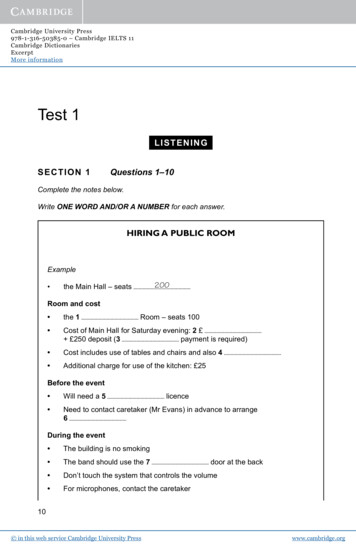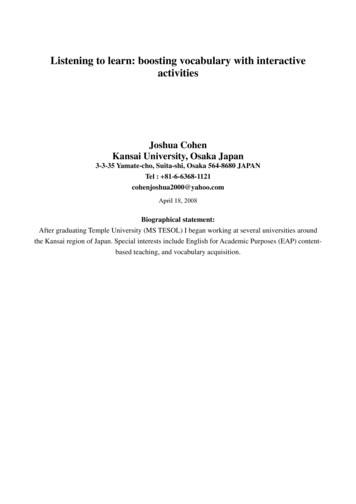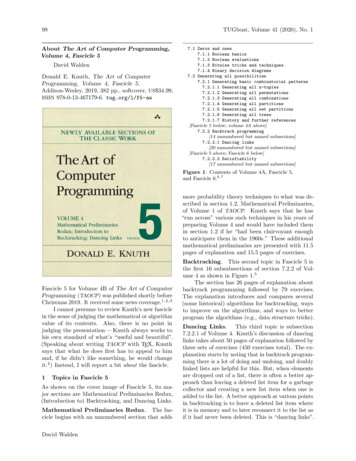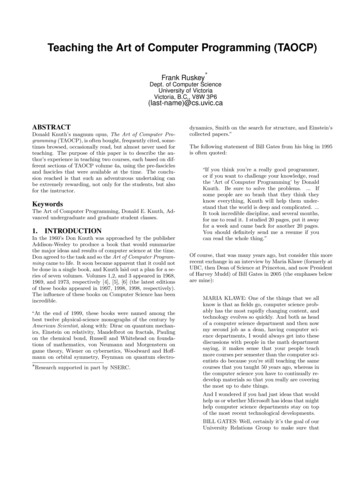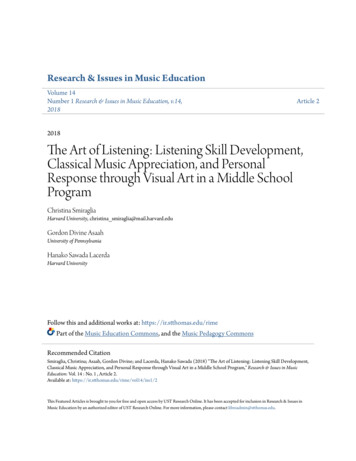
Transcription
Research & Issues in Music EducationVolume 14Number 1 Research & Issues in Music Education, v.14,2018Article 22018The Art of Listening: Listening Skill Development,Classical Music Appreciation, and PersonalResponse through Visual Art in a Middle SchoolProgramChristina SmiragliaHarvard University, christina smiraglia@mail.harvard.eduGordon Divine AsaahUniversity of PennsylvaniaHanako Sawada LacerdaHarvard UniversityFollow this and additional works at: https://ir.stthomas.edu/rimePart of the Music Education Commons, and the Music Pedagogy CommonsRecommended CitationSmiraglia, Christina; Asaah, Gordon Divine; and Lacerda, Hanako Sawada (2018) "The Art of Listening: Listening Skill Development,Classical Music Appreciation, and Personal Response through Visual Art in a Middle School Program," Research & Issues in MusicEducation: Vol. 14 : No. 1 , Article 2.Available at: https://ir.stthomas.edu/rime/vol14/iss1/2This Featured Articles is brought to you for free and open access by UST Research Online. It has been accepted for inclusion in Research & Issues inMusic Education by an authorized editor of UST Research Online. For more information, please contact libroadmin@stthomas.edu.
Smiraglia et al.: The Art of Listening: Listening Skill Development, Classical MusiAbstractAlthough many programs aim to develop students’ listening skills and promote theappreciation of Western classical music, relatively few such programs incorporate visual art.This study examined the perceived effectiveness of the Edinburgh International Festival’s (EIF)Art of Listening program in reaching its stated goals to: develop skills for listening, encouragethe enjoyment of listening to Western classical music, break down preconceptions held aboutWestern classical music, cultivate a deeper relationship with the imagination through music andart, and encourage students’ personal responses to music. Focusing primarily on the first threegoals, this study gathered data from 78 students from six upper primary classes (generallystudents ages 11 or 12) from four schools located in the Edinburgh, Scotland metropolitan area.Findings from student and teacher surveys before and after the program as well as programobservations indicate that participants perceive that the Art of Listening program achieves thespecific objectives examined, at least in the short-term. Both students and teachers respondedpositively to the program’s unique combination of listening skill development, classical musicappreciation, and responses to music through visual art. The article discusses considerations forimplementing similar programs in other contexts and makes suggestions for future research.IntroductionConsidering students’ interests and needs related to music education is important for highinterest, engagement, and a thorough music education (Kaschub & Smith, 2014) as well as tocreate personal connections between students and subject matter. One program that tackles thisissue by providing supplemental music education as a field trip opportunity is the EdinburghPublished by UST Research Online, 20181
Research & Issues in Music Education, Vol. 14 [2018], No. 1, Art. 2International Festival’s (EIF) Art of Listening program. Even though the focus of the EIF’s workis their annual festival of the same name, the Scottish organization also offers year-roundclassical music programming for a variety of audiences, including school groups. The programmoves beyond simply offering music appreciation or music history by facilitating interactivestudent explorations of what it means to listen, live professional musical performances, andpersonal responses to music through visual art creation, in addition to covering the history,elements, and popular contemporary uses of Western classical music.There is an abundance of research on how to develop students’ listening skills (seeArcavi & Isoda, 2007; Jalongo, 1996; Norkunas, 2011; Sims, 2005; Smialek & Boburka, 2006;Thompson, Leintz, Nevers, & Witkowski, 2004; and Wilson, 2003). Thompson et al. (2004)offered a four-stage model for effective listening that included preparation, listening processmodel application, evaluation, and future goal setting. More recently, Kerchner (2014) discussedbest practices and expanding listening skills to strengthen theoretical understandings andconcrete ways of applying musical listening, which eventually lead to musical enjoyment. Thepurpose of listening skill development can range from understanding the historical context ofmusic and discovering new genres or traditions of music to learning specific elements of music(Kaschub & Smith, 2014). Besides being a key element of music education, listening is alsoimportant for students in general social interactions—in the classroom and beyond. However,we have found no studies of programs that combine the development of student listening skillswith imaginative personal responses to listening through visual art.Studies exploring visual art’s impact on cultivating imagination and providingopportunities of expression are plentiful (see Alerby, 2000; Özsoy, 2012; and Villarroel &Infante, 2014). Often, students’ responses through art are analyzed to understand their 2
Smiraglia et al.: The Art of Listening: Listening Skill Development, Classical Musiabilities (Lambert, 2005), communication skills (Watts & Garza, 2008), knowledge of serioussubjects such as death (Marsal & Dobashi, 2011) or the environment (Alerby, 2000), culturalvalues (Andersson, 1995), or general intellectual acuity (Brooks, 2009). However, almost noresearch has been done on programs that use visual art to capture responses to music. Kerchner(2014) discussed the use of listening maps, in which students translate what they hear intopersonal, non-standard musical notation and also create visual images illustrating personalconnections to music, but examples are otherwise lacking.Although much has been written on how to promote interest in Western classical music(see DePascale, 2003; Green & Hale, 2011; Kolb, 2000; Levin, Pargas, & Austin, 2005; Shuler,2011; and Woody & Burns, 2001), less is known about how to break down preconceptions aboutthe genre. Kolb (2000) lamented the dearth of research on the attitudes and preferences ofuniversity students about music. She explored university students’ preconceptions aboutclassical music and found beliefs that classical music concerts were expensive and thatconcertgoers were well-to-do economically, older, and possessed some requisite “specialknowledge” (p. 17) about classical music. Although responses after attending a classical concertwere mixed—depending on the particular concert students had taken part in—the studentsgenerally enjoyed the classical music (Kolb, 2000). Building on Kolb’s study, Dobson (2010)collected data from nine culture consumers who did not attend classical music events and foundthat their experiences were affected by their lack of knowledge and preconceptions aboutclassical music. For instance, some thought that “classical performances are, by their verynature, perfect” (p. 116) and so did not know how to judge the performances, while others sorevered the music that they felt a “moral obligation” (p. 118) to like it.Published by UST Research Online, 20183
Research & Issues in Music Education, Vol. 14 [2018], No. 1, Art. 2Given the relative dearth of literature on how to break down conceptions about classicalmusic, particularly in students, and on how the visual arts can be used as a vehicle for students toexpress their responses to music, thereby improving their listening skills, the intent of the currentstudy was to begin addressing those gaps by examining the Edinburgh International Festival’sArt of Listening program and its combination of these different elements into a single two-hoursession. The stated goals of the Art of Listening program are actually many: Nourish the individual by cultivating a deeper relationship with the imagination throughthe use of music and art. Cultivate a meaningful relationship with performance. Explore an experiential and participative approach to listening. Introduce Western classical music by developing creative skills for listening. Encourage the enjoyment of listening to Western classical music. Explore and encourage the listener’s personal response to music. Break down the preconceptions sometimes held about Western classical music. Increase accessibility to EIF’s musical repertoire across age ranges. Explore the dynamic between the musician and the individual / audience (EdinburghInternational Festival, 2007).Exploring all of these goals was beyond the scope of this project; this exploratory study focuseson examining whether there is evidence that the program promotes the development of creativeskills for listening, encourages the enjoyment of listening to Western classical music, and breaksdown preconceptions sometimes held about Western classical music. This research sought toimprove our understanding of whether and how a multi-dimensional program may facilitate thesebeneficial outcomes, with the hope that the Art of Listening program may be useful as a modelhttps://ir.stthomas.edu/rime/vol14/iss1/24
Smiraglia et al.: The Art of Listening: Listening Skill Development, Classical Musifor future program development, both in other out-of-school music education contexts as well aspotentially in school music curricula.ProgramSiteThe Art of Listening program is presented on-site at the EIF’s headquarters at The Hub,an architectural landmark in the city of Edinburgh—a neo-Gothic building completed in 1845 tohouse the General Assembly of the Church of Scotland, the Church’s governing body(Edinburgh International Festival, 2014). The building was renovated in 1999 to become the EIFheadquarters, and modern additions include a colorful entryway and a red stairwell fitted withhundreds of sculpted figures. The Hub sits on the Royal Mile near Edinburgh Castle, with a tallspire visible from many locations (see Figure 1).Figure 1. The Hub, the Edinburgh International Festival’s headquartersPublished by UST Research Online, 20185
Research & Issues in Music Education, Vol. 14 [2018], No. 1, Art. 2The program takes place in the main hall, which is two stories tall with a vaulted ceiling, stainedglass windows, elaborate wooden carvings, and large chandeliers. Before students arrive, thestaff set up the room with chairs arranged in rows facing a piano and monitor as well as an openspace with mats, pillows, and a clipboard with drawing materials (see Figure 2).Figure 2. Main hall in The Hub, set up for the Art of Listening programStaffThere are three primary and two secondary staff members associated with the Art ofListening program. The primary facilitators are the EIF’s Head of Programme Development, aprofessional pianist, and a professional vocalist. The Head of Programme Development overseesthe program, offering an introduction and facilitating focused listening response activities at theend of the program. The two professional musicians jointly facilitate the middle parts of theprogram. In addition, the EIF’s Creative Learning Officer and a teaching artist who assists withvarious EIF programs both support the program as well. The Creative Learning Officer assistshttps://ir.stthomas.edu/rime/vol14/iss1/26
Smiraglia et al.: The Art of Listening: Listening Skill Development, Classical Musiwith booking and fielding correspondence with interested schools, and both assist with setup andbreakdown of program materials.Program StructureThe program is offered approximately 16 days per year for schools in the Edinburghmetropolitan area. Year 7 students come as an entire class, and up to about 40 students canparticipate at each session. (Year 7 is the last year of primary school and approximatelycorresponds with fifth grade in the United States.) Numbers are maximized within sessions totry to include as many classes as possible, although there is so much interest in the programcurrently that 30 – 40% of interested classes cannot be accommodated. Those who have notparticipated in the program in the past year are given priority for registering. Free buses areprovided by EIF between schools and the program site.The program lasts for two hours and is offered up to twice per day, in the morning andafternoon. As students enter, they are given name tags, which facilitators use to call on studentsby name during the program. The program begins with a 20-minute introduction to the EIF anddiscussion of listening. The Head of Programme Development (Programme Head) starts byasking the students if they know what the EIF does, and she shows a brief video to orient theaudience to the work of the organization and introduce the facilitators. She then asks thestudents to talk about what kind of music they listen to and like; if no students bring up classicalmusic, she asks what they think of it. The Programme Head states that the session is “aboutclassical music and about listening.” Students are asked if they think they are good listeners, ifthey ever struggle with listening, and what happens when they do not listen. The ProgrammeHead discusses different brain waves and their relationship to energy levels, mentioning that thePublished by UST Research Online, 20187
Research & Issues in Music Education, Vol. 14 [2018], No. 1, Art. 2students have internal resources to keep themselves attentive, if they want to be. Thisintroduction grounds the program within the organization and also gets the students immediatelythinking about the topic of listening and its personal connections to their lives.After the introduction, the pianist and vocalist perform a duet, which is used to discussnorms around listening such as the common practice of clapping at the end of a performance aswell as student expectations of understanding what they hear. Following the duet, the pianistasks if any students play
Art of Listening program in reaching its stated goals to: develop skills for listening, encourage the enjoyment of listening to Western classical music, break down preconceptions held about Western classical music, cultivate a deeper relationship with the imagination through music and art, and encourage students’ personal responses to music. Focusing primarily on the first three

